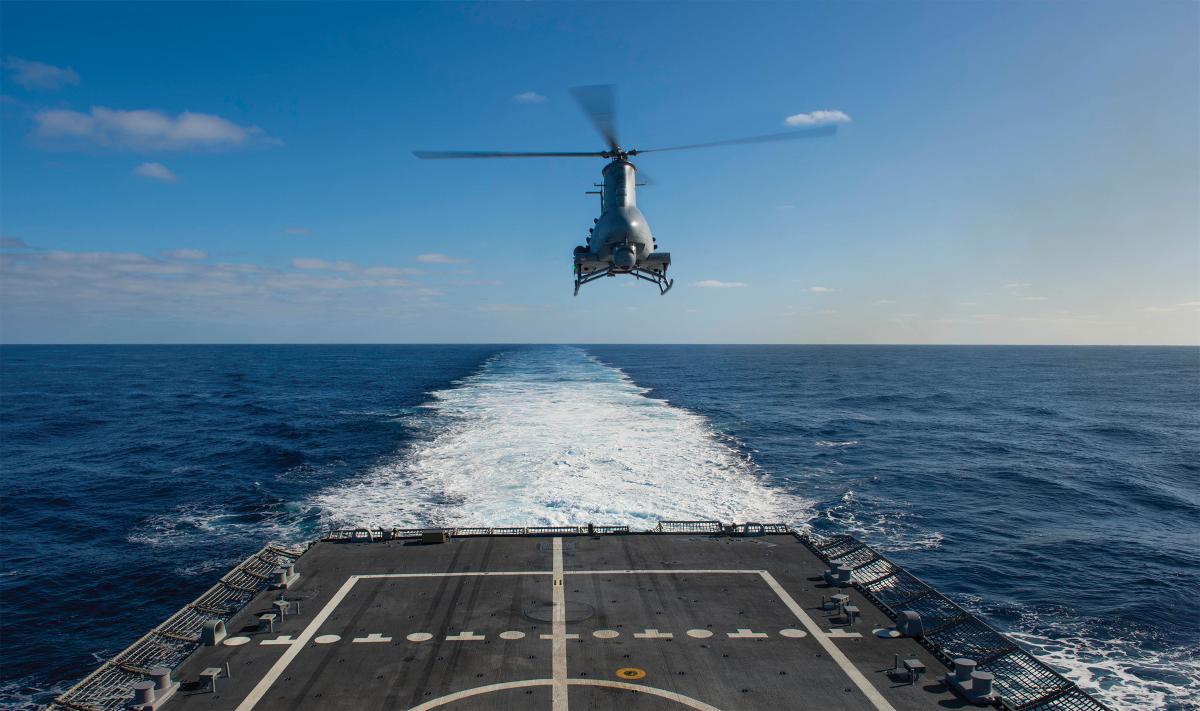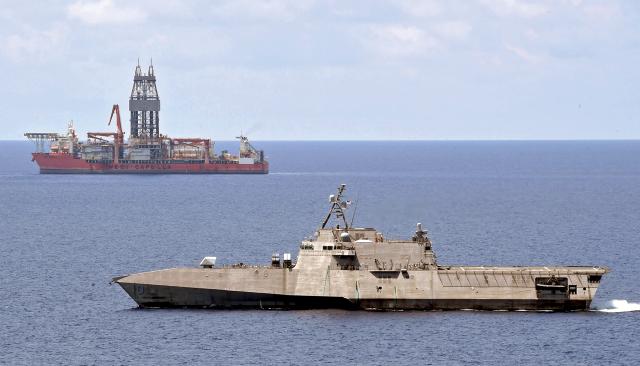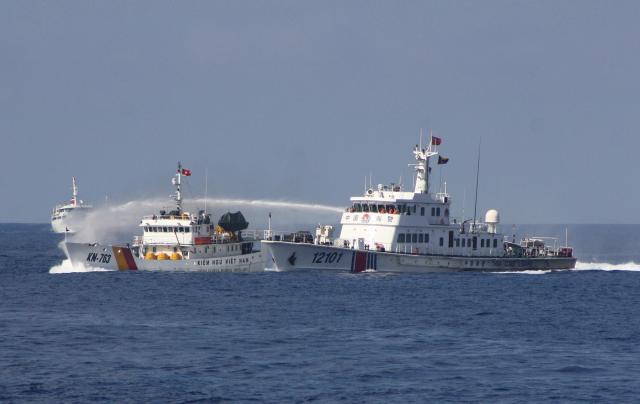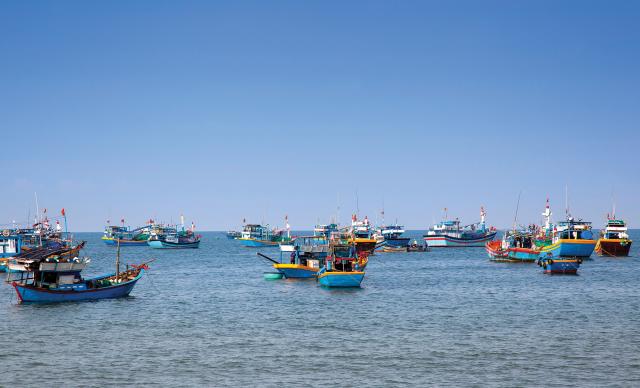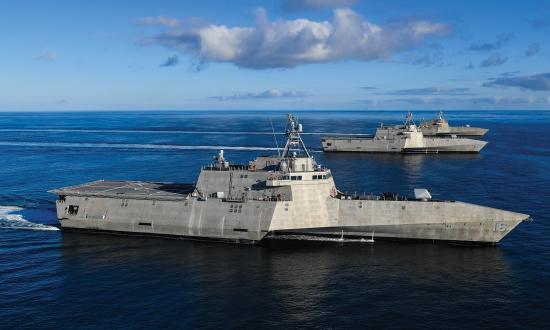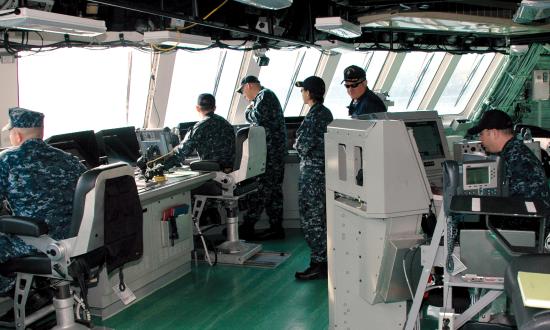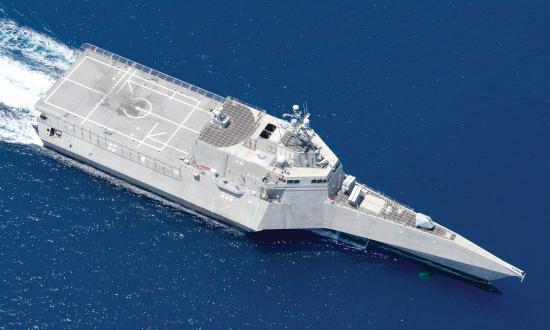The U.S. Pacific Fleet is embracing its role in countering China’s maritime insurgency against the rule of international law and freedom of the seas. Persistent presence to safeguard Southeast Asian civilians from China’s depredations against their rights is the new order of the day and already is delivering favorable political-diplomatic results.1
In April 2020, key U.S. partner Malaysia was undertaking a hydrocarbon survey of its internationally recognized exclusive economic zone (EEZ), and its vessels were being continually harassed by the China Coast Guard and People’s Armed Forces Maritime Militia. In response, three U.S. ships, led by the USS America (LHA-6), sailed into the South China Sea to discourage this coercive behavior. Being capital ships, the America and her immediate strike group could remain in the vicinity only approximately a week before needing to sail north for further tasking, including freedom of navigation operations (FONOPS) through the Spratly and Paracel Islands and a Taiwan Strait transit. This led some observers to lament yet another apparent instance of high-end U.S. warships making transient appearances in the South China Sea.2
This narrative was quickly countered by the use of Destroyer Squadron 7’s littoral combat ships (LCSs), the USS Montgomery (LCS-8) and Gabrielle Giffords (LCS-10), the latter equipped with the new Naval Strike Missile, to sustain U.S. presence near the Malaysian drillship. Rotationally deployed to Singapore, the two LCSs made repeated patrols through the contested area, creating an opening for public signaling in several forms. The Navy affirmed through photographic imagery and full-throated statements from Pacific Fleet Commander Admiral John Aquilino, Seventh Fleet Commander Vice Admiral Bill Merz, and Task Force 76 Commander Rear Admiral Fred Kacher the U.S. commitment to defending free seas and Southeast Asians’ international rights to their offshore resources. China’s official reactions were uncharacteristically restrained, stating even during the most muscular U.S. deployment that the situation in the South China Sea was “improving.”3 Supported by this U.S. response, the Malaysian-contracted drillship was able to successfully conclude its survey as previously scheduled, despite Chinese pressure.
The episode, a prototype implementation of the maritime counterinsurgency (COIN) concept, demonstrated the promise of this approach. It also highlighted the utility of the much-maligned littoral combat ships as instruments of the persistent low-end force presence that is the mainstay of this new strategy. This revelation hints at a deeper insight: The long-prevailing narrative of the LCS’s inadequacy in the face of great power threats is increasingly out of date.4 Despite its long and tortuous development history, the LCS may be just what the Navy needs in the western Pacific.
Though the original concept of swappable “mission modules” has not panned out, the challenge of China’s maritime insurgency against freedom of the seas inside the first island chain has created a need for a small surface combatant with the LCS’s attributes of shallow draft, expansive and reconfigurable internal space, large flight deck, and armament centered on rapid-firing guns and offensive antiship missiles. Combined with the LCS’s relative place in the Navy’s wider fleet architecture, these characteristics make the platform a near-ideal candidate to bring to bear unmanned systems and intermediate force capabilities. These emerging technologies could play an essential role in enabling economies of force and more effective responses to subkinetic aggression as part of a maritime counterinsurgency campaign. In the return to great power competition, the times have found the LCS.
The Challenge: China’s Maritime Insurgency
For all the public fixation on its expanding high-end warfare capabilities, China’s decisive line of revisionist effort is, in fact, centered below the threshold of armed conflict. Rather than embarking on a costly large-scale war of aggression, China is waging a maritime insurgency in the South China Sea, working to brusquely subjugate and coerce the more than 3.7 million people in Southeast Asia who depend on access to those waters for their daily livelihoods.5 The objective of China’s campaign is to overturn the rule of international law that enshrines freedom of the seas, a long-accepted legal principle in international jurisprudence and a core U.S. national interest since the earliest days of the republic. In its place, Beijing seeks to impose its own draconian and self-serving vision of maritime sovereignty, under which distant ocean areas can be claimed like land, as “blue national soil,” to disenfranchise weaker coastal states from their EEZs and fundamental legal rights at sea.6
If China’s maritime insurgency is allowed to proceed unchecked, civilian mariners will be forced to submit to Beijing’s dictates, and its outlandish claims to “indisputable sovereignty” over 90 percent of the South China Sea will in time become an accepted fact of customary international law and a precedent for avaricious countries elsewhere.7 This would be a disastrous outcome for the United States and the world.
The successful defense of its vital interest in free seas calls for the United States to wage a campaign of maritime counterinsurgency, positioning its own forces and working by, with, and through allies and partners to protect local civilian mariners from Chinese depredations. As demonstrated by the success of the Pacific Fleet’s prototype implementation of this concept in April and May 2020, maritime counterinsurgency in the South China Sea requires U.S. forces to expand beyond their legacy model of periodic high-end presence—exemplified by large surface combatants conducting FONOPS every few months—and establish a complementary, persistent, low-end presence in proximity to local civilian maritime populations.8 This posture must be militarily robust enough that China could disrupt it only through a substantial escalation and must have a reliable “credible permanence” in the eyes of the civilian population to be politically effective.
These conditions create two key constraints. First, a maritime counterinsurgency operation must be highly efficient in its use of resources to allow the effort to remain indefinitely sustainable (and thus credibly permanent) while preserving the fleet’s high-end capacity to win and deter a kinetic war. Second, so long as China continues to share the view that its interests are best pursued short of war, U.S. and allied forces will face significant limits on their ability to directly compel the People’s Liberation Army Navy (PLAN) and China Coast Guard with kinetic weapons.
This operating environment of maritime counterinsurgency indicates a need for specific attributes of the vessels allocated to the low-end presence task. Many of the civilian vessels that require protection are fishing boats, which frequently cluster in the shallow water near the reefs and shoals that are found throughout the aptly named “Dangerous Ground.” This makes shallow draft a valuable asset for the U.S. and allied ships in closest proximity to their civilian charges. Many interactions with Chinese forces are likely to take place at relatively close quarters, within visual range at distances better suited to guns than missiles should matters escalate. Based on the expectation of a limited force allocation, individual platforms would benefit from being able to carry multiple offboard reconnaissance systems to expand the area a single manned asset can cover.
LCS and Emerging Tech
In addressing the limitations on resources and use of force that would be intrinsic to a maritime counterinsurgency campaign, two areas of emerging technologies have the potential to create new opportunities for U.S. and allied forces.
Unmanned Systems. The joint force uses and is in the process of testing an array of unmanned aerial vehicles (UAVs), unmanned surface vessels (USVs), and unmanned underwater vehicles (UUVs). These systems will play important roles in intelligence, surveillance, and reconnaissance (ISR); electronic warfare, mine countermeasures, antisubmarine warfare, magazine capacity, and logistics.9 The main advantage of unmanned systems is that they permit the deployment of sensors, systems, and weapons on less expensive, more plentiful vehicles without the physical and financial costs or risk to life of an onboard human crew. From a resource perspective, their comparatively lower cost allows more units to be procured. Operationally, the removal of onboard human operator stations and associated life support systems enables a marked reduction in physical size or an increase in other mission-critical qualities (range, endurance, payload, etc.) that can either permit more individual units to be packed in a constrained space (e.g., a shipboard hangar) or improve the overall utility of the asset.
Intermediate Force Capabilities. Likewise, significant advances have been made in the field of intermediate force capabilities—a spectrum of systems that cause reversible, nondestructive effects intended to fill the gap between mere presence and lethal effects. These include a variety of directed-energy systems, such as high-powered microwaves that can be used to remotely disable outboard motors; optical dazzlers to obscure the vision of potential threats or adversary sensors; occlusion technologies to reduce the efficiency of a vessel’s propellers; millimeter-wave active denial systems to cause an intolerable but nonlethal heating sensation to personnel; and various means of disabling small UAVs. Whereas current equipment is oriented toward a vision of military force as an on-off switch for kinetic action, these new systems offer wider decision space for action in more ambiguous circumstances.10
This is where the LCS can make valuable contributions. LCSs are plentiful enough to be effective in support of maritime counterinsurgency and have the space, weight, power, and cooling capacities to field these new technologies. They also already have the infrastructure in place through Destroyer Squadron 7 to support rotational deployments to the theater, operating from Singapore.
Many of the harsh judgments rendered on the LCS have centered on their original concept of operations, which entailed placing what would otherwise be integral onboard capabilities into a swappable package that would allow a given hull to configure as a swarm boat killer, an antisubmarine hunter, or a minesweeper. The problems with two of these three mission modules have been at the center of the criticism, as these essentially have stripped the LCS of the ability to operate as originally envisioned. These past faults acknowledged, both variants of the LCS were built with a set of attributes that makes them more adaptable than their designers envisioned and more useful than their critics have allowed.11
Reenvisioning the LCS
The LCS’s characteristics are conducive to the rapid integration of new systems. Both variants have flight decks substantially larger than standard surface ships: The Freedom variant’s is 7,300 square feet, while the Independence variant’s flight deck is 11,100 square feet—the largest of any surface combatant in the fleet, apart from carriers and amphibious warfare ships.12 The LCS-1’s flight deck is large enough to support two MQ-8 Fire Scouts or one MH-60 Seahawk; LCS-2’s flight deck potentially could land two MH-60 helicopters simultaneously in an emergency and has the room to land a V-22 Osprey or a CH-53K Sea Stallion, if configured to do so.13
Both variants have flexible “mission bays,” LCS-1’s being 6,500 square feet and LCS-2’s being 15,200 square feet. These spaces are equipped with numerous high-capacity power outlets intended to service the original mission modules and could be adapted to support a variety of unmanned systems and intermediate force capabilities. The mission bays are made more valuable by their impressive cargo-handling capabilities. The LCS-2 variant has an elevator that allows the crew to move 20-foot standard shipping containers between the flight deck and the mission bay while at sea.
Both variants can be used for a variety of purposes, from the cycling of unmanned vehicle loads, to replenishment of new kinds of onboard and offboard weapon systems and intermediate force capabilities, to armed resupply of Marines operating expeditionary advanced bases. In addition, the LCS-2 variant has a side access ramp for vehicle and CONEX box roll-on/roll-off loading alongside a pier, as well as movement of mission modules or berthing modules. Both also have large stern gates to allow the safe launch and recovery of small boats and other watercraft.
Other of the LCS’s intrinsic qualities make it particularly well adapted and indeed essential to the requirements of maritime counterinsurgency. Capable of speeds in excess of 40 knots, the LCS is maneuverable on both the tactical and operational/strategic levels. Both variants can go from flank speed ahead to making sternway in a matter of ship lengths, and the LCS-2 variant can twist within her own length. High sprint speed allows the LCS to rapidly reposition to reinforce different groups of civilian vessels requiring protection, enabling greater economy of force, while tactical agility confers advantages in close maneuvering situations, such as dodging would-be rammers. Likewise, when running on diesels alone at low speed, the LCS consumes significantly less fuel than other surface combatants on gas turbines, allowing greater persistence when loitering on station.
Operationally and strategically, its 14-foot draft permits the LCS to operate closer to shore and in waters substantially shallower than those navigable by larger surface combatants, almost all of which draw in excess of 30 feet. This increases the Navy’s ability to influence events in the South China Sea as well as several other strategically important “marginal seas,” opening new venues for security cooperation with partners and allies. In addition, the LCS can call on 1,111 ports worldwide, more than three times the 362 ports accessible by its heftier counterparts.14 The ship’s draft already has paid tactical dividends. When the USS Coronado (LCS-4), operating in the shoal-strewn South China Sea on her first deployment to the region in 2016, was set on by a pair of PLAN frigates, she took advantage of her lighter draft to steer into shallower waters than her pursuers could safely follow and successfully eluded the tail.
Water-jet propulsion confers additional advantages on the LCS when navigating areas frequented by fishing vessels, where buoys, nets, and other flotsam can foul propellers. In the event of escalation, the LCS’s combination of rapid-firing 57-mm and 30-mm guns position it well for close-quarters engagements with the swarms of smaller vessels of the People’s Armed Forces Maritime Militia and the China Coast Guard, while its new Naval Strike Missiles give it a powerful punch against more capable PLAN surface combatants. And new concepts under consideration, such as flight-deck mounted box missile launchers and greater integration with Marine Corps littoral expeditionary forces, would provide an even wider scope of available options on the kinetic end of the spectrum.
LCS: The Navy’s Maritime Counterinsurgent in Waiting
The LCS has a future as the principal platform for the first wave of integration of unmanned systems and intermediate force capabilities into the surface fleet. The LCS could play a critical “midfield” role in a maritime counterinsurgency campaign, operating alongside or as the flagship of a flotilla of manned and optionally unmanned patrol vessels and aircraft on the front lines of protecting civilian mariners from Chinese coercion, or as part of a covering task force to guard light patrol forces against higher-end threats.15 Given Task Force 76 and Destroyer Squadron 7’s victories in the standoff in the Malaysian EEZ, as well as in subsequently deterring a Chinese vessel from undertaking a survey in the Vietnamese EEZ, the Navy should accelerate the deployment of additional Naval Strike Missile–equipped LCSs to Singapore and embark top-line ISR assets such as MH-60 Romeo and unmanned systems to maximize efficiency and effectiveness in this strategically decisive operation.16
The Navy has defended free seas in the western Pacific in peace, gray zone confrontation, and war for more than two centuries, and the moment has come for the LCS to take up this mantle.17 If the Navy rethinks its concept of operations to leverage its key characteristics in bringing to bear new technologies, the LCS can play an essential role in maintaining a free and open Indo-Pacific and securing free seas for generations to come.
1. LT Lauren Chatmas, USN, “Montgomery, Cesar Chavez Operate Near West Capella,” Destroyer Squadron 7, 7 May 2020, cpf.navy.mil/news.aspx/130611.
2. Euan Graham, “U.S. Naval Standoff with China Fails to Reassure Regional Allies,” Foreign Policy, 4 May 2020, foreignpolicy.com/2020/05/04/malaysia-south-china-sea-us-navy-drillship-standoff/.
3. Sam LaGrone, “China Issues Muted Response to U.S. Warships Near South China Sea Standoff,” USNI News, 21 April 2020, news.usni.org/2020/04/21/china-issues-muted-response-to-u-s-warships-near-south-china-sea-standoff; LCDR Blake Herzinger, USNR, "Learning in the South China Sea: The U.S. Response to the West Capella Standoff," War on the Rocks, 18 May 2020, /warontherocks.com/2020/05/learning-in-the-south-china-sea-the-u-s-response-to-the-west-capella-standoff/.
4. Sam LaGrone, “Navy Responds to Pentagon LCS Survivability Claims,” USNI News, 17 January 2013, news.usni.org/2013/01/17/navy-responds-pentagon-lcs-survivability-claims; “Littoral Combat Ship (LCS) and Associated Mission Modules,” Department of Operational Test and Evaluation, FY15 Navy Programs, dote.osd.mil/Portals/97/pub/reports/FY2015/navy/2015lcs.pdf?ver=2019-08-22-105642-770; and James Holmes, “The U.S. Navy’s Littoral Combat Ship: A Successful Catastrophe?” The National Interest, 26 January 2020, nationalinterest.org/blog/buzz/us-navys-littoral-combat-ship-successful-catastrophe-117311.
5. Gregory Poling, “Illuminating the South China Sea’s Dark Fishing Fleets,” Stephenson Ocean Security Project, CSIS, 19 January 2019, ocean.csis.org/spotlights/illuminating-the-south-china-seas-dark-fishing-fleets/.
6. See Hunter Stires, “The South China Sea Needs a ‘COIN’ Toss,” and “Why We Defend Free Seas,” U.S. Naval Institute Proceedings 145, no. 5 (May 2019), and “Win without Fighting,” U.S. Naval Institute Proceedings 146, no. 6 (June 2020).
7. CAPT Daniel Straub, USN, “WEST Theater: A ‘COIN’ Toss in the South China Sea: Defending Free Seas and the Rule of International Law from China’s Maritime Insurgency,” panel comments, U.S. Naval Institute AFCEA WEST Conference, 3 March 2020.
8. CAPT Josh Taylor, USN, “WEST Theater: A ‘COIN’ Toss in the South China Sea: Defending Free Seas and the Rule of International Law from China’s Maritime Insurgency,” panel comments, U.S. Naval Institute AFCEA WEST Conference, 3 March 2020.
9. “Exploring China’s Unmanned Ocean Network, Asia Maritime Transparency Initiative,” 16 June 2020, amti.csis.org/exploring-chinas-unmanned-ocean-network/.
10. Megan Eckstein, “Pentagon’s Non-Lethal Weapons Office Pushing Gray-Zone Warfare Tools,” USNI News, 24 September 2019, news.usni.org/2019/09/24/pentagons-non-lethal-weapons-office-pushing-gray-zone-warfare-tools.
11. See Daniel Straub, “Keep the Newest Frigate on Course,” U.S. Naval Institute Proceedings 144, no. 4 (April 2018); Holmes, “The U.S. Navy’s Littoral Combat Ship: A Successful Catastrophe?”
12. The LCS-1 variant includes odd hull numbers 1 through 31; the LCS-2 variant includes even hull numbers 2 through 38.
13. Adding the capability to land a V-22 Osprey or CH-53 Sea Stallion would require adding increased structural modifications to the LCS, such as heat shields, and strengthening the load-bearing capacity of flight deck supports.
14. Martin N. Murphy, Littoral Combat Ship: An Examination of Its Possible Concepts of Operation (Washington, DC: Center for Strategic and Budgetary Assessments, 2010): 20, csbaonline.org/research/publications/littoral-combat-ship-concepts-of-operations.
15. See Stires, “Win without Fighting.”
16. Drake Long, “U.S. Again Patrols Near Chinese Survey Ship in South China Sea,” Radio Free Asia, 2 July 2020, rfa.org/english/news/china/usa-southchinasea-07022020194749.html; Tweet by @DESRON_7, 2 July 2020, twitter.com/DESRON_7/status/1278627986372083713?s=20; PO2 Brenton Poyser, USN, “USS Gabrielle Giffords Operates in the South China Sea,” DVIDS, 30 June–1 July 2020, dvidshub.net/image/6260266/uss-gabrielle-giffords-operates-south-china-sea; Drake Long, “China’s Coast Guard Shows Up at Vanguard Bank Again,” Radio Free Asia, 7 July 2020, rfa.org/english/news/china/vietnam-southchinasea-07072020183440.html.
17. See Hunter Stires, “1941 Asiatic Fleet Offers Strategic Lessons,” U.S. Naval Institute Proceedings 142, no. 8. (August 2016), and “‘They Were Playing Chicken’—The U.S. Asiatic Fleet’s Gray-Zone Deterrence Campaign against Japan, 1937–40,” Naval War College Review 72, no. 3 (Summer 2019).




